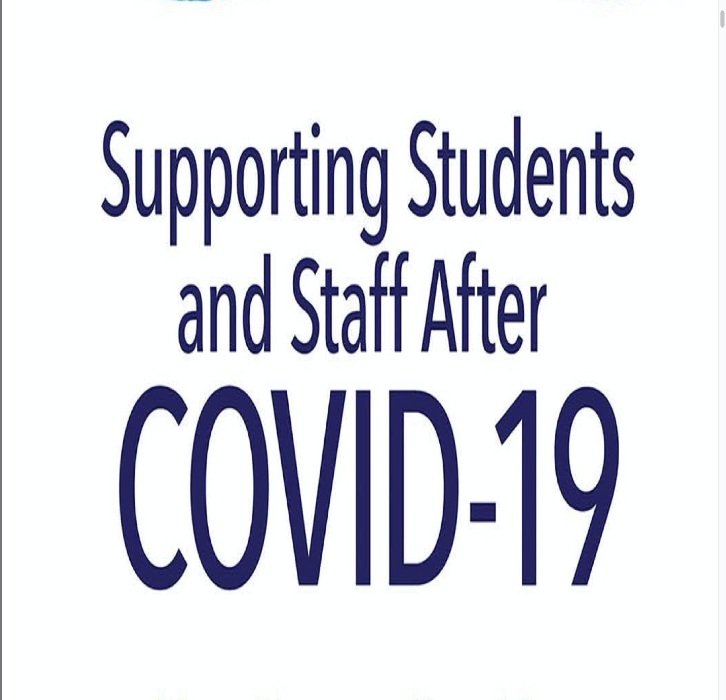A new book for trauma-sensitive educators
Returning to school this year has been stressful for school leaders, educators, families, and students, whether they’re engaged in face-to-face, distance, or hybrid learning. My new e-book Supporting Students and Staff After COVID-19 is a resource designed especially for administrators, teachers, instructional coaches, and support staff. It provides *right now* suggestions about how to soothe stress responses so that everyone in the elementary school setting can be ready for teaching and learning.
Readers will find discussion questions, suggestions for meeting the diverse needs, lessons that facilitate community-building, and more. Throughout, educators are encouraged to focus on equity as well as their own self-care when building trauma-sensitive learning environments.
The book highlights four essential questions in building trauma-sensitive schools:
- Feel safe – Could this decision cause harm?
- Be connected – Would it tend to people’s right now feelings and needs?
- Get regulated – Is it just right for promoting regulation?
- Learn – Will this help the student(s) learn?
Could this decision cause harm?
The first question centers on safety. If the answer is yes, don’t do it. For example, an instructor may want to assign the following writing prompt:
“The best thing about the pandemic has been…”
Start by imagining a worst-case scenario, for example a student in the classroom has experienced the death of a loved one due to COVID-19, but no one at school knows. The prompt could cause harm for that student because the pandemic brought loss and potential trauma into their world. The student would likely feel alone in their grief and perhaps unsafe at school. Therefore, don’t assign the prompt.
Now if a student decides to write about a similar topic on their own, that’s okay. They made a choice for themselves. Teachers won’t always know students’ trauma histories, nor are they entitled to that information. Assume trauma is in your school (it is) and make decisions accordingly.
Will it tend to people’s right now feelings and needs?
The second question involves attuned relationships. Educators must work together to notice and meet the needs of one another, their students, and families. Educators might fear triggering students’ trauma, and as a result, avoid anything related to the pandemic in their classrooms. That decision, however, wouldn’t tend to people’s right now feelings and needs. Adults and youth benefit from opportunities to share as little or as much as they want about their feelings in a supportive environment. Invite, don’t force students to share in open ended check-ins. Don’t know what to ask? The book includes downloadable check-in resources.
Is it just right for promoting regulation?
How do we know if something is too much or not enough? What if individuals need something different from the group? Never mentioning COVID-19 at school is an extreme case of not enough. Trying to help students process their emotions in the classroom setting is likely too much, especially since the pandemic is ongoing. Learn more about how to utilize trauma-informed multi-tier systems of supports (MTSS) so that you can meet everyone’s varied needs. From there, connect students with personnel or services when they need more support than a classroom teacher can provide.
Will this help students learn?
The last question entails asking if what you’re about to do will help students access an appropriate education. If your decision helps students feel safe, connect with others in a healthy way, and get regulated, then it helps them get closer to learning. If it doesn’t do any of these things, don’t do it.
When you can answer “Yes” to each of the four questions, consider proceeding with your decision. Then, evaluate how it is working and how it is supporting students and staff. Adjust when necessary. What we do as trauma-sensitive educators matters. How we go about making and carrying out decisions matters even more.
Want to learn more?
Would you like to learn more about becoming a trauma-sensitive educator? Do you want to work on supporting students and staff? Would you like to learn how to utilize trauma-informed MTSS to meet the needs of all students, including those who have experienced severe traumatization? Consider participating in my online institute for one, two, or all three days this fall, from Thursday, November 19 through Saturday, November 21, 2020. Come by yourself or with a team for a supportive and interactive learning. Leave with practical strategies and an action plan. Learn more and register is here.
Hope to see you there!
Jen Alexander (M.A., NCC, SB-RPT) believes educators can make a difference in the lives of all students, one relationship at a time. That’s why she’s a leader in the movement to build trauma-sensitive schools. As an experienced educator, trauma expert, professional development facilitator, and author of Building Trauma-Sensitive Schools as well as Supporting Students and Staff After COVID-19, Ms. Jen is passionate about supporting youth and the educators who serve them. For more information, follow her on social media.
Website: MsJenAlexander.com
Facebook: https://www.facebook.com/Ms.JenAlexander/
Instagram: @msjenalexander
Twitter: @MsJenAlexander



